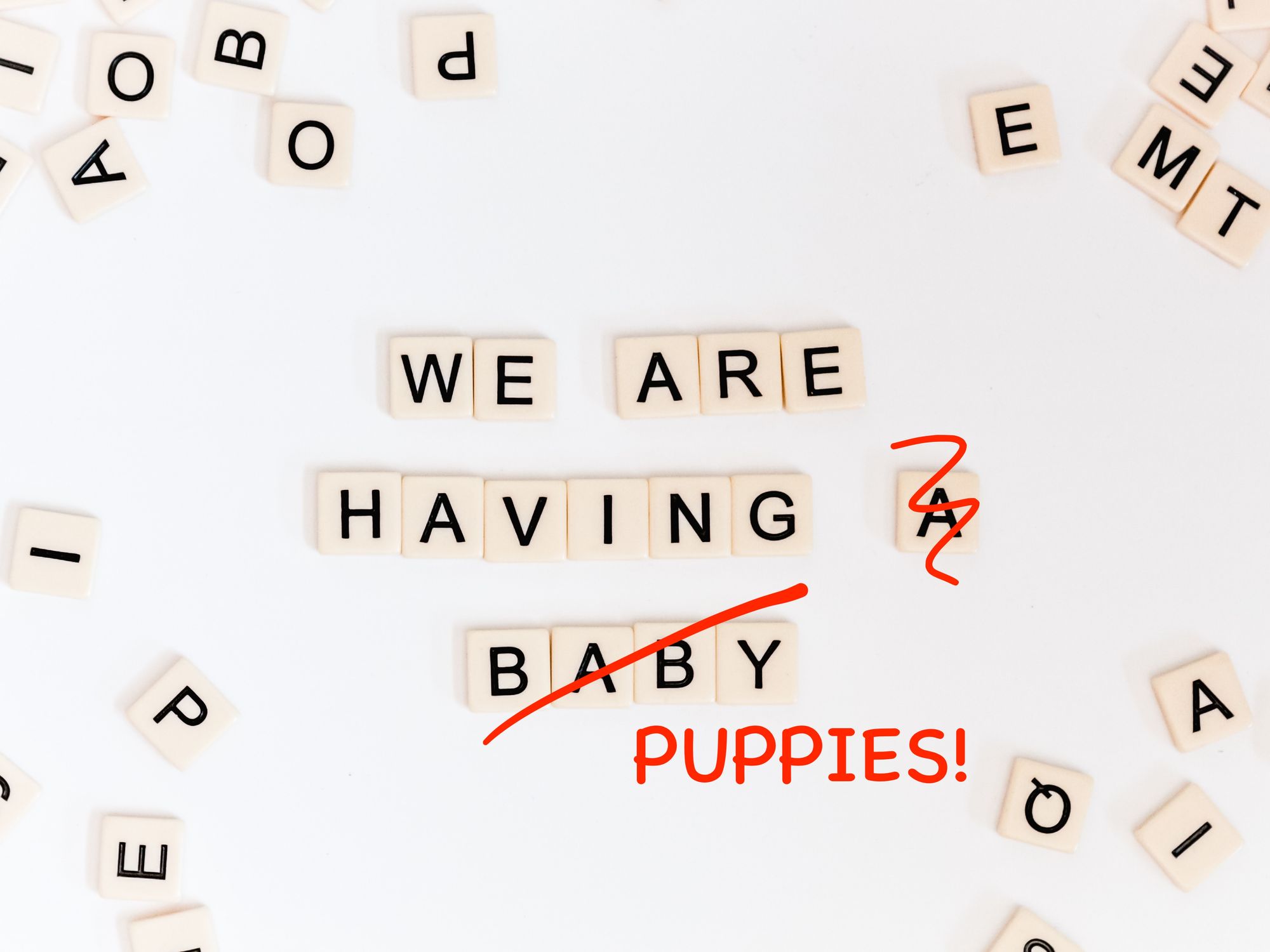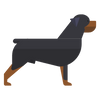Your Guide to Pregnancy in Rottweilers: Step-by-Step

If you are a Rottweiler owner considering breeding or if your Rottweiler is already pregnant, understanding the pregnancy process is crucial. This article will provide a comprehensive guide on Rottweiler pregnancy, covering everything from the early signs of pregnancy to the care needed during this period.
A Rottweiler's pregnancy lasts 8-10 weeks, producing 6-12 puppies. Conception marks Day 1, presumably the first day of mating. You may notice behavioral changes, enlarged dark nipples, weight gain and an increase in appetite. Birth should last 6-18 hours, with each puppy born about one hour apart.
I will explain each aspect of a Rottweiler's pregnancy in detail in the article below. You will not only find information on her natural heat cycle, but also how to care for both your Rottweiler and her new puppies.
Please note, some of the links on this site are affiliate links which help support the running of this site at no additional cost to you.
Rottweiler Pregnancy & Beyond
Pregnancy involves everything from your Rottweiler's heat cycle, gestational preiod and birth to caring for your Rottie and her new litter afterwards.
The Heat Cycle & The Fertile Window
Female Rottweilers can go "in heat" as early as six months of age, but it's more common around one year old. The heat cycle consists of four stages: Proestrus, Estrus, Diestrus, and Anestrus, which you can read about in detail here.
Note: It is not recommended to breed your Rottweiler during her first heat cycle as she is still growing herself. A rottweiler reaches adulthood at around two years old.
The Estrus phase of this cycle is a 9-day period where your Rottweiler is fertile. This is characterised by straw-colored discharge and a wrinkled vulva. You will know this time is near when your Rottweiler bleeds and her vulva swells, as this is the Proestrus phase that preceeds Estrus.

Preventing Pregnancy:
If you are reading this in an attempt to prevent pregnancy, closely monitor your Rottweiler's cycle. As soon as she bleeds, you know that she is close to being in heat.
When you notice that your Rottweiler is in heat, avoid leaving her outside alone. This includes in a fenced yard as she or a male dog may be able to jump the fence (look at this article to see how high they can actually jump!).
If she has to be around male dogs, secure her "danger zone" with something like a doggy diaper for that time (such as this one on Amazon.com).
A Rottweiler's Pregnancy
The first thing you need to know about your Rottweiler's pregnancy is how to recognise when she is actually pregnant. Identifying the early signs of pregnancy in your Rottweiler can help you provide the necessary care and prepare for the arrival of puppies.
Signs of Pregnancy:
- Increased appetite
- Weight gain
- Changes in behavior (eg. more affectionate, clingy, more relaxed, reduced interested in male dogs)
- Changes to nipple size and color (larger and a deeper pink color)
- 'Nesting' behavior (rearranging blankets, pillows or laundry to create a safe place to birth and nurse her puppies)
The Gestation Period
The gestation period for a Rottweiler, like most dogs, typically ranges from 57 to 65 days, with an average of 63 days. This equates to 9 weeks' gestation. This period can slightly vary depending on the dog's age and overall health.
It's important to note that your Rottweiler can safely deliver up to a week before or after the 63-day mark. Therefore anything from 8-10 weeks' gestation is considered a full-term pregnancy.
Day 1 of your Rottweiler's gestation is typically considered to be the day of ovulation, which occurs during the estrus stage. However, pinpointing the exact day of ovulation can be challenging without veterinary intervention, such as hormone level testing or ultrasound.
In general, if you're tracking a pregnancy, you can count from the first day of mating. Just keep in mind that this might not align exactly with the day of ovulation.
If you are unsure and want to confirm the puppies' gestational age, a vet can provide an ultrasound for you. This will also confirm how many puppies are in the litter, as Rotterilers usually have between 6 to 12 puppies in one pregnancy.
Caring for Your Pregnant Rottweiler
Proper care during pregnancy is essential for the health of both the mother and her puppies. This includes providing a balanced diet, regular exercise, and regular vet check-ups.
As the pregnancy progresses, your Rottweiler may require 15-25% additional calories in her food. This should be a balanced diet rich in proteins, fats, and carbohydrates. Calcium is also important for the development of your puppies' bones.
If your Rottweiler is on a raw diet, make sure she is getting enough nutrients from the foods she is eating through different meats, bones and organs. Find out more here.
Regular exercise is another important thing to consider, but rest is equally as important. So try not to push her too far on your walks. You can find a good guide on how to exerice your Rottweiler here.
You should also prepare a comfortable and quiet space for your Rottweiler to give birth (if she hasn't already made one for herself). Massages and lots of attention will help her feel comfortable and loved during this exciting time.
The Birthing Process
As your Rottweiler approaches the end of her pregnancy, you should be prepared for the birthing process. The birthing process for Rottweilers can last from 6-18 hours.
Typically, puppies are born approximately one hour apart. However, this can vary, and some dogs may take a longer or shorter time between births.
During the birthing process, provide a quiet and comfortable space for your Rottweiler. Be present to monitor for any complications, but try not to interfere unless necessary. Her natural instincts will kick in and she will know what to do.
Despite all this, it is still crucial to have a vet on call during this process in case of any complications. If your Rottweiler is having trouble giving birth, don't hesitate to contact your vet immediately. They can provide guidance and can judge whether a cesarean section is necessary.
Signs of complications that you should watch for include the following:
- Prolonged labor
- Distress
- Excessive bleeding
- More than two hours pass without a puppy being born
Once your Rottweiler relaxes and starts to clean or nurse her puppies, you know the birthing process is over. Knowing how many puppies to expect from an ultrasound can be helpful, but it is not necessary. Just keep in mind that there should be one placenta for every puppy born.
Post-Pregnancy Care
After the birth, your Rottweiler and her puppies will require special care. This includes ensuring the mother is healthy and able to nurse her puppies, and that the puppies are feeding properly and developing as they should. Regular vet check-ups are therefore essential during this period.
Caring for the Mother
After the birth, it's important to clean up the area, provide fresh bedding, and ensure there's food and water available nearby for your Rottweiler. The environment should be kept as stress-free as possible, as you would expect for any new mother.
If you are wanting to breed your Rottweiler again, she can technically get pregnant the first time she goes into heat after giving birth. After birth, she will enter the Diestrus stage of her cycle (60 days), followed by Anestrus(90-150 days). Once these stages are complete, she will re-enter Proestrus, leading into heat/Estrus.
However, it is not recommended to breed your Rottweiler back-to-back. It is better to at least wait until she has weaned her current litter and her body has fully recovered before breeding again.
Caring for the Puppies
The puppies should be nursing frequently and should be kept warm and comfortable. They will drink their mother's milk exclusively until 4-weeks old, followed by their mother's milk and solids until 8-weeks old. After 8 weeks, the puppies can be weaned.
Up until 3-weeks old, you do not need to socialize your Rottweiler's puppies. After three weeks, you can start by gently handling them and introducing them to a variety of people, environments, and other animals. Just make sure it is done in a safe and controlled way.
I hope this guide has helped you understand a Rottweiler's pregnancy. This can help ensure a safe and healthy process for both the mother and her puppies. If you are already expecting a litter, congratulations and best wishes!

